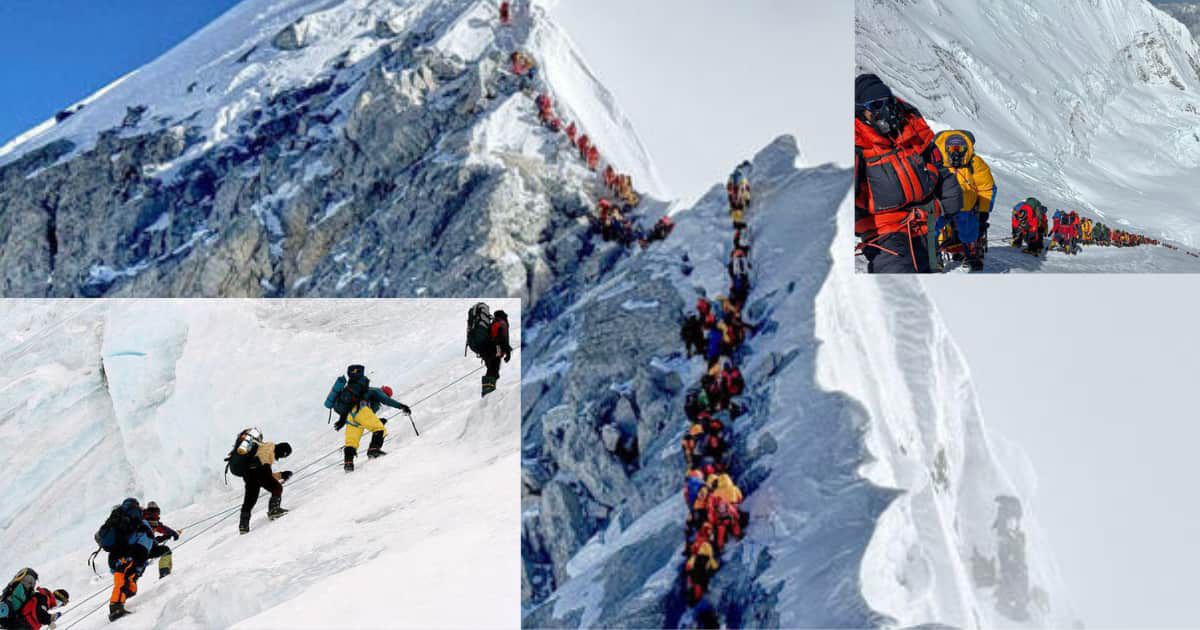
Traffic Jam at the Top: Crowds, Chaos, and the Climb Up Mount Everest
MAHARAJGANJ, UP: High above sea level, where oxygen thins and weather can turn hostile in moments, hundreds of climbers waited their turn — clipped onto a single rope, inching toward the roof of the world. Despite harsh and unpredictable conditions, the spring 2025 climbing season on Mount Everest saw another surge of summit attempts, with long queues forming near the top in what’s become infamously known as the “Everest traffic jam.”
As the May window — considered the most favourable for summit bids — drew to a close, climbers and their Sherpa guides made a final push to reach the 8,849-metre (29,032-foot) peak. This year, however, the rush collided with unusually volatile weather, forcing climbers to navigate a deadly mix of snow, wind, and human congestion.
According to Nepal’s Department of Mountaineering, 468 foreign climbers from 57 countries received permits to attempt Everest this season. Including Sherpa support staff, the total number of people on the mountain easily crossed 900. With all of them aiming for the summit during a narrow window of good weather, bottlenecks became inevitable — especially in the “death zone,” where every minute can mean life or death.
Challenging Weather and Crowded Slopes
This year’s climbing season was dominated by one factor: unreliable forecasts. Veteran climbers and guides report that weather conditions often shifted drastically within hours, making it hard to plan summit pushes safely.
“The forecast would say it’s clear, and then by the next hour, the wind and snow would pick up,” said Jenjen Lama, a six-time Everest summiteer. “Many teams were caught off guard.”
With limited windows of decent weather, expedition teams were forced to coordinate their final ascents within a compressed timeframe. That created gridlock near key chokepoints such as the Hillary Step and the South Summit — narrow paths where climbers can only proceed in a single file, clipped to a single rope line.
“This isn’t just about delays,” Lama added. “In the death zone, waiting too long can be fatal. Your body starts shutting down.”
Beginner Boom, Safety Bust
One of the key issues behind Everest’s growing congestion is the rising number of first-time climbers with limited mountaineering experience. While many come well-prepared, others rely heavily on Sherpa support or lack basic technical skills, making progress slower and increasing the risk for everyone on the mountain.
Pasang Rinji Sherpa, who has successfully summited Everest twice, believes a more stringent qualification system should be put in place.
“Right now, you have professionals and complete beginners on the same route at the same time,” he said. “That’s a problem. There needs to be basic training requirements. Climbers should at least know how to use their gear and how to respond in emergencies.”
The call for regulations is not new. Mountaineering veterans have long urged the Nepali government to enforce minimum experience criteria, such as successful ascents of 6,000 or 7,000-metre peaks before attempting Everest. Yet, the booming demand — and the revenue it brings — makes such measures difficult to enforce.
A Crowded Mountain, A Commercialised Dream
Climbing Everest was once a feat reserved for elite alpinists. Today, it’s a booming industry. With guided expeditions, advanced gear, and Sherpa logistics, the summit is more attainable than ever — but at what cost?
The commercialisation of Everest has brought much-needed income to Nepal’s economy, particularly to the Sherpa communities that support these expeditions. But it’s also turned the mountain into a high-altitude traffic zone, where summit dreams sometimes clash with survival reality.
“People come thinking it’s a trophy climb,” said a base camp medic who asked not to be named. “But they underestimate how brutal this mountain is. Altitude sickness, frostbite, and exhaustion can hit anyone.”
The situation has also reignited ethical concerns around the burden placed on Sherpas. Many guides make multiple ascents in a single season, fixing ropes, carrying heavy loads, and rescuing climbers — often under extreme physical stress.
One such figure, Kami Rita Sherpa, again etched his name in the record books this season by summiting Everest for a record 31st time. A symbol of endurance and experience, Kami Rita’s feat stands in sharp contrast to the growing number of climbers attempting Everest without prior high-altitude exposure.
A Dangerous Climb Through the Death Zone
Above 8,000 metres lies the death zone — a place where oxygen levels are so low that the human body begins to deteriorate, even when resting. Here, climbers must contend not just with the terrain and weather, but with their own biology. Decisions must be made quickly, and delays can be deadly.
In 2019, a now-viral image showed a long line of climbers near the summit, many visibly exhausted and dangerously exposed. Since then, the phrase “Everest traffic jam” has entered public consciousness, symbolizing both the allure and the perils of high-altitude tourism.
While this year did not see any such widely circulated photographs, accounts from climbers suggest that the situation remains largely the same. At peak hours, some waited more than two hours in line to reach the summit or descend — a risky delay in an already oxygen-starved environment.
72 Years Since the First Ascent
This year’s climbing season also marked a significant anniversary: 72 years since Sir Edmund Hillary and Tenzing Norgay first stood atop Everest on May 29, 1953. Their historic ascent inspired generations, transforming the mountain into a global icon of adventure and resilience.
But many believe that today’s Everest stands at a crossroads — one where popularity must be balanced with preservation and safety. Without better regulation, experts warn, the mountain may become even more dangerous in the years to come.
“Everest will always attract people,” said Jenjen Lama. “But if we want fewer accidents and a better climbing experience, we have to control how many go, and who goes.”
Awadh360 plus
As the season winds down, authorities and expedition organizers are once again under pressure to find solutions. Proposals include:
• Limiting daily summit attempts through time-slot systems.
• Mandatory training programs for climbers before receiving permits.
• Digital tracking of climbers to manage crowd flow.
• Environmental impact monitoring to reduce waste on the mountain.
For now, though, Everest remains both a stage for human triumph and a stark reminder of nature’s dominance. The traffic jams, the queues, and the struggles are part of the Everest story — one that continues to evolve with every climbing season.
Popular Categories
Read More Articles
Travel and Tourism
Indian Railways to Prioritise Aadhaar-Linked Accounts in First 10 Minutes of Tatkal Booking Window by Awadh 360° Desk June 5, 2025Travel and Tourism
India Records 9.66 million Foreign Tourist Arrivals in 2024, Still Far Behind South East Asian Nations by Awadh 360° Desk June 3, 2025Travel and Tourism
Hajj Journey Delayed, Not Denied: Libyan Pilgrim’s Faith Grounds Plane Twice by Awadh 360° Desk May 28, 2025India
Why India’s Kaveri Engine Project Is Trending — and Why It Matters? by Awadh 360° Desk May 28, 2025



